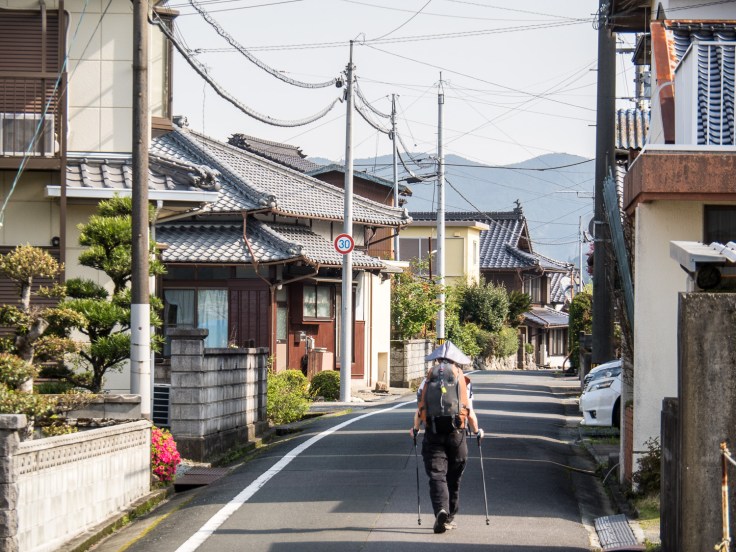April 22, 2017
Today’s walk will be bittersweet. An easy 20 kilometers from now we will reach Ōzu, the endpoint of our springtime walk along the Henro-michi.
After a good Japanese-style breakfast, Gail and I set off from Matsu-ya, our business hotel in Unomachi. Budget-conscious Simon has foregone the expense of a hotel meal and is already on his way to his morning fast food fix at a Lawson’s convenience store.
The pilgrimage route takes us down the quiet streets of Unomachi, then Uwa. Or so we think. There is little definition, few clear boundaries and, it seems, no signage to tell us when we leave one community and enter another. But that is not unusual here on Shikoku. Streets just flow like a river from town to town, merge into rice paddies and cross forested valley floors, only to re-emerge in another community.
Walls of period-style buildings line the tight streets. Elaborately detailed façades and screens, delicately crafted in dark-stained wood, animate our passage. Occasionally, the pattern is disrupted by a starkly modern block-of-a-house, set in a broad expanse of asphalt. Soon enough the dense urban tapestry unravels into the usual strip development of gas stations and utility buildings. As we pass Lawson’s at the edge of town, Simon pops out and joins us on our final day of pilgrimage.
Yesterday’s Temple 43 was the last ‘official’ temple Gail and I would encounter on this trip. However, the Henro-Michi is fairly littered with temples and shrines of all sorts. As we emerge from a pleasant trail through the low wooded hills near Ōzu, a stone statue of Kōbō Daishi appears to one side. It’s almost lost in the untended scrub brush that is slowly invading the ruins of a small temple. This is Fudakake Daishidō, the now forlorn resting spot for the likeness of our patron pilgrim.
The hilly path drops us onto a highway and down into a valley sheltering our final destination, Ōzu City. It’s a strange entrance. In the distance, perched on the other side of the valley is a very Gothic-looking cathedral, certainly the first sign of a Christian outpost we have seen on Shikoku.
That spiritual monument is counterpointed on our side of the valley by Forest Stay Resort. Rows of handsome two-storey suites encircle a tidy courtyard. It’s a pleasant-looking oasis, surrounded by woods and gated from the highway. But it’s all too quiet. Drapes are drawn tight. Carports are curtained shut. Signage makes it clear that rooms are available on an hourly basis. This, we deduce, is a classy version of the Japanese love hotels found in most cities, a place where young couples can come for anonymous rendezvous.
Ōzu City itself is a charming community with streetscapes of well-preserved traditional houses and stores. In summer, fishermen can be seen on the Hiji-kawa River, using cormorants to catch their fish. But for Gail and me, Ōzu City is most notable for its train station, the place where we will be departing from our pilgrimage journey for this season.
We purchase our train tickets to Yawatahama and rejoin Simon in the square outside to say our goodbyes. Simon intends to complete the Henro-michi, another 400-plus kilometres of walking. Our plan is also to complete the pilgrimage, but we will have to wait for autumn. We will return to Winnipeg for the summer and, in late October, come back to this very spot in Ōzu City to resume our trek across the island of Shikoku.
Fate has intervened, requiring us to break our Henro-michi trek into three separate trips. Admittedly, these 19 days of walking have come and gone far too quickly. Standing here at the train station, watching Simon disappear around the corner, we feel like should be joining him. Walking, step after step, day after day, has become the norm. It is our sutra, our chant, our spiritual path. And it is hard to stop.
A short train ride take us to the port city of Yawatahama. There’s enough time to explore the town and check out the port where, very early tomorrow morning, we will catch a ferry to the island of Kyushu. That will be the start of our rail tour to several Japanese cities.
There’s a roof top lounge in our hotel. We settle in for cocktails and sake. The sun glows orange as it sets over the bay. It’s a spectacular view, the perfect setting for our last night on Shikoku. We raise our glasses in cheer. Kanpai to our 19 days on the 88 temple pilgrimage route. Kanpai to our upcoming tour. Kanpai to our return later this year.
Addendum:
Heike, a German follower of WalkClickMake, emailed me to point out how much she enjoys the blog. She walked the entire Shikoku pilgrimage in 2015 and saw the cathedral mentioned in my blog post above. She also saw a sign in Japanese that roughly translates as “Marry Me” and wanted to pass on to me that the cathedral was more likely a wedding facility than an actual religious building.
I have done a little bit of research and was able to locate this site on Google Maps. Sure enough, it is a commercial wedding venue (thank you Heike!). It’s called Marriyell and, if you are interested, it has a splashy website at http://www.marriyell.co.jp/ozu/.
What Gail and I spied across the valley was just the tip of the iceberg. Aside from the towering Gothic-style cathedral that we saw, there is also a small Colonial-style chapel and a sprawling Renaissance or Baroque-style banquet hall. All three are clustered tightly around a small courtyard, a veritable theme park of re-imagined Western architecture.
So the relationship of the cathedral to the Forest Stay Resort is not so much contrapuntal, as suggested in my blog post above. The connection is – dare I say – more linear in nature.



































Leave a Reply